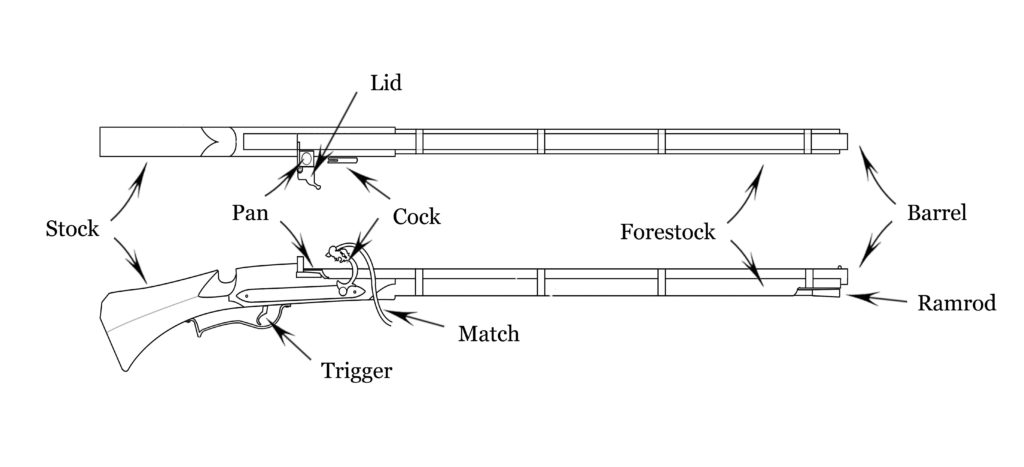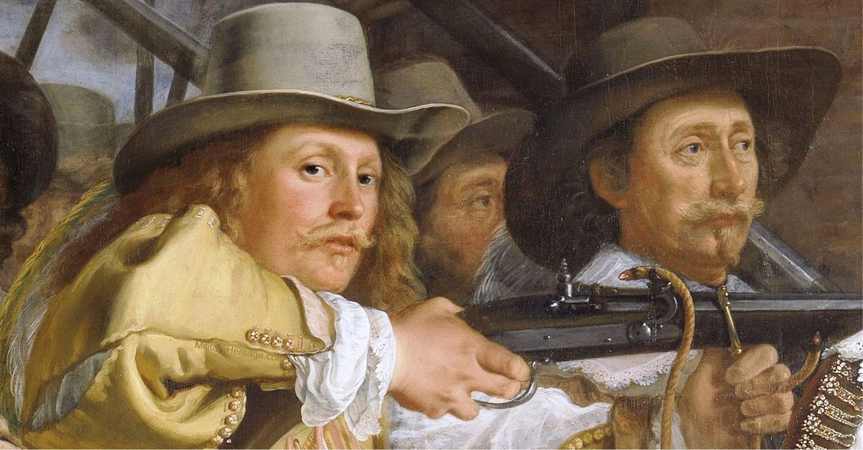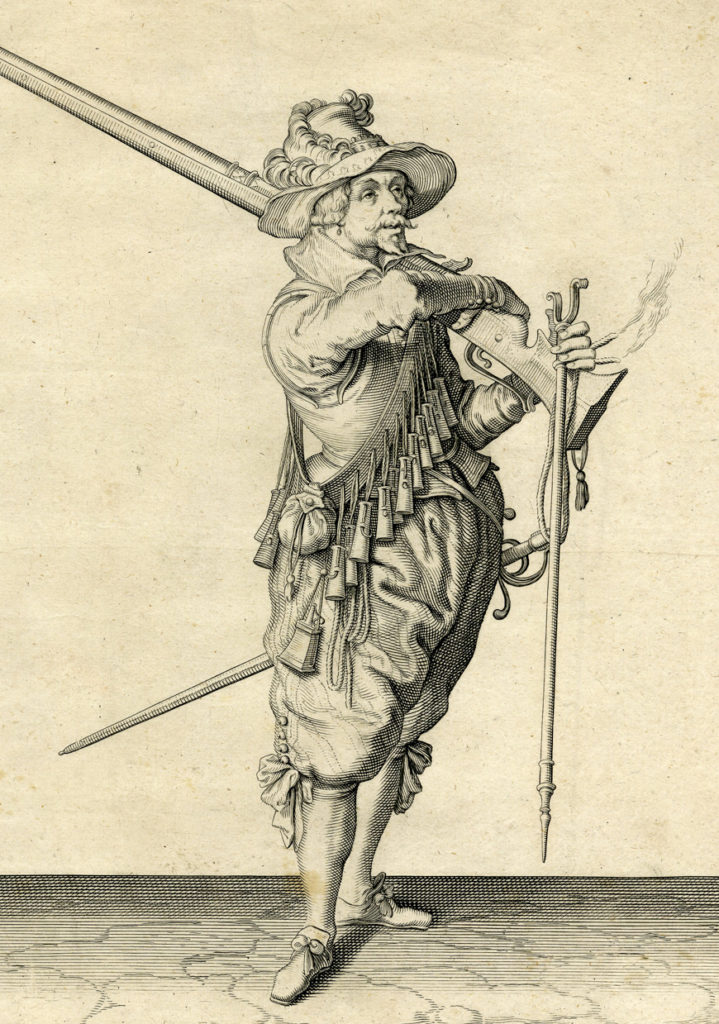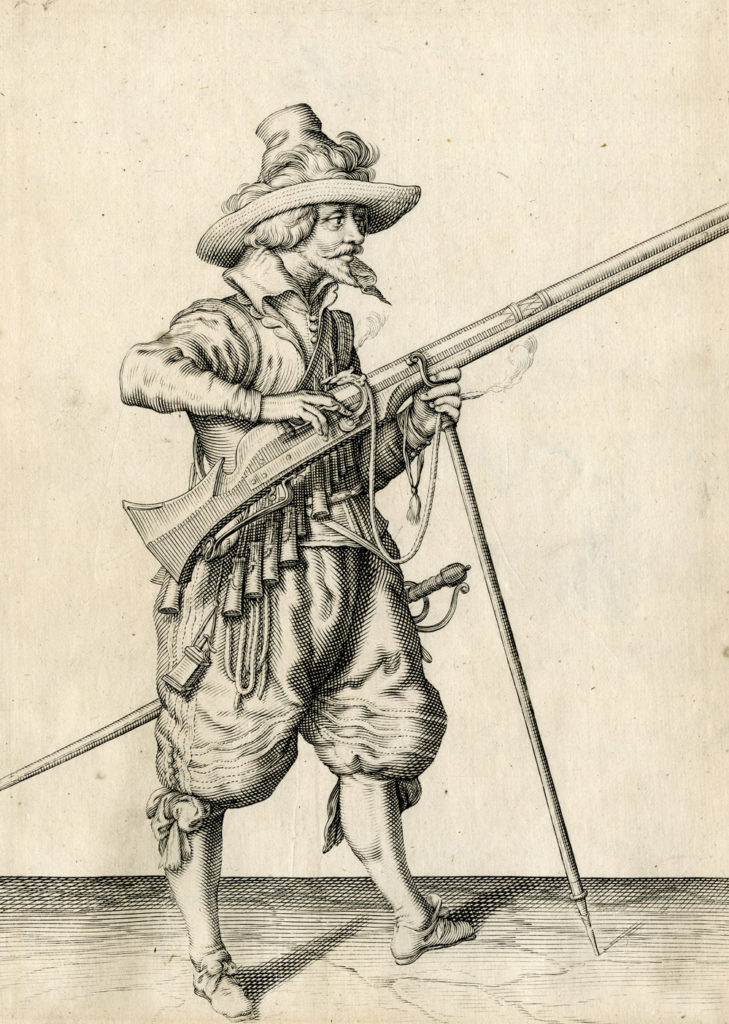(This post is a continuation of Muskets – Part 1. If you haven’t done so already, it’s best to read that post before continuing on here.)
Barbary corsairs—like everybody else at the time—were armed with muskets. However, in the seventeenth century they were not armed with flintlock muskets.
Flintlocks, remember, were first devised in the early-mid seventeenth century, but they didn’t really become the standard, universal version of the musket until the eighteenth century. In the first half of the seventeenth century, when Barbary corsairs were boiling out of the Mediterranean and rising in power, they would not have been systematically equipped with flintlocks.
Instead, the vast majority of them would have been armed with matchlock muskets.
Matchlocks worked on the same general principle as flintlocks. They were muzzle loaders. You poured a charge of gunpowder down the barrel, thumbed a lead musket ball into the barrel’s mouth, and then rammed it all home with the ramrod so that powder and ball were solidly seated in the bottom end of the barrel.
Like flintlocks, matchlocks had a priming pan. You poured finely ground gunpowder into the pan and set fire to it. This, in turn, set the main charge in the barrel alight.
It was the method of setting the priming powder alight that differentiated flintlocks from matchlocks. In a flintlock, the hammer had a piece of flint set into it. When you pulled the trigger, the hammer flicked forwards, striking the frizzen. This created a spark that set the priming powder alight in the pan.
In a matchlock, the lit end of a length of slow-burning cord—known as the “match,” hence the name of the gun—set the priming powder alight. The match cord (usually hemp or flax) was impregnated with nitre (potassium nitrate) so that, once lit, it burned slowly but persistently—it was also referred to as a slow match.
Below is a diagram of a matchlock.
As you can see in the diagram, the match was held in a device called a “cock” that gripped the burning end of the match cord. Once the cock had been set, you pulled the trigger, and the cock flicked downwards into the pan, allowing the burning end of the match to make contact with the priming powder and set it alight.
Matchlocks were reasonably reliable (unless it was raining, of course), but they were more complicated to use that flintlocks. An early seventeenth century manual (an English translation of a Dutch book) titled The exercise of armes for caliures, muskettes, and pikes provided instruction for how to operate a matchlock musket. Here is the short version of the steps involved in firing a loaded matchlock and then preparing it to fire again (I have included explanations in brackets where it seemed necessary; the matchlock is referred to as a “piece”):
- Shoulder your piece and march.
- Unshoulder your piece.
- With the right hand hold it up.
- In the left hand take your piece.
- In the right hand take your match [the length of slow-burning match cord].
- Hold well your match and blow on it [to make sure the burning end of the match cord is still lit].
- Cock your match [attach the lit end of the burning match cord to the cock].
- Try your match [adjust the match cord in the cock so that the lit end is in the right position].
- Blow on your match and open your pan [slide the lid off the pan].
- Present your piece [aim].
- Give fire [shoot].
- Take down your piece, and in the left hand hold it well.
- Uncock your match [remove the match cord from the cock].
- Hold your match betwixt your fingers.
- Blow out your pan [blow out any gunpowder residue remaining in the pan].
- Prime your pan [pour gunpowder into the pan].
- Shut your pan [slide the lid over the pan].
- Shake your pan [to get rid of any gunpowder residue].
- Blow on your pan [to get rid of any remaining gunpowder residue].
- Turn your piece about [set the musket on the ground with the barrel upwards].
- To your left side let it sink.
- Open your charges [take out a packet containing a pre-measured charge of gunpowder].
- Charge your piece [put the gunpowder and a musket ball into the mouth of the barrel].
- Draw out your shoving-stick [slide the ramrod out of the forestock of the musket].
- Grasp the shoving-stick.
- Ram your powder [use the ramrod to push the charge of powder and the musket ball down the barrel].
- Draw your shoving-stick out of your piece [pull the ramrod out of the barrel].
- Take it shorter [grasp it by the end].
- Put up your shoving-stick [slide the ramrod back into the forestock].
- With the left hand bring forward your piece.
- With the right hand hold your piece up.
- Shoulder your piece.
- Hold your piece well upon your shoulder, and march to the place of guard.
- Unshoulder your piece.
- In the left hand let it sink.
- Hold your piece well.
- With the left hand alone hold your piece.
- In the right hand take your match.
- Blow on your match.
- Cock your match.
- Try your match.
- Blow on your match and open your pan.
- Stand ready.
- Present your piece.
- Give fire.
As you can see, firing a matchlock was a fairly complicated process.
They were also quite heavy weapons.
In the image below, you can see a musketeer standing with his matchlock “shouldered.” Notice the size of the gun. Notice also the forked stick he is holding in his left hand. Matchlocks were generally too heavy to aim accurately without something to rest the barrel on—hence the forked stick (often referred to as a “rest”).
Below is an image of a musketeer firing his matchlock, using the rest.
Below is another image of a musketeer, “locked and loaded” (so to speak) and ready to fire his weapon.
Notice the bandoleer of small bags slung across the chest of this musketeer (and the first one above). These are the pre-loaded charges of gunpowder the musketeer would stuff into the barrel.
Notice, also, the wide-brimmed hats that these musketeers are all wearing. They wore such hats, apparently, because the wide brims helped keep the rain from soaking the powder in the priming pain (they were only minimally effective, but better than nothing).
______
Barbary corsairs, of course, were not musketeers. Musketeers were specialized military units, usually part of the regular army. There wasn’t a lot that was ‘regular’ about Barbary corsairs.
For a discussion of the role matchlock muskets played in the Barbary corsair activities, see the next post in this blog.

Corsairs and Captives
Narratives from the Age of the Barbary Pirates
View Amazon listing
The Travels of Reverend Ólafur Egilsson
The story of the Barbary corsair raid on Iceland in 1627
View Amazon listing


